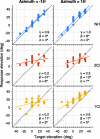Sound Localization in Real-Time Vocoded Cochlear-Implant Simulations With Normal-Hearing Listeners
- PMID: 31088265
- PMCID: PMC6535744
- DOI: 10.1177/2331216519847332
Sound Localization in Real-Time Vocoded Cochlear-Implant Simulations With Normal-Hearing Listeners
Abstract
Bilateral cochlear-implant (CI) users and single-sided deaf listeners with a CI are less effective at localizing sounds than normal-hearing (NH) listeners. This performance gap is due to the degradation of binaural and monaural sound localization cues, caused by a combination of device-related and patient-related issues. In this study, we targeted the device-related issues by measuring sound localization performance of 11 NH listeners, listening to free-field stimuli processed by a real-time CI vocoder. The use of a real-time vocoder is a new approach, which enables testing in a free-field environment. For the NH listening condition, all listeners accurately and precisely localized sounds according to a linear stimulus-response relationship with an optimal gain and a minimal bias both in the azimuth and in the elevation directions. In contrast, when listening with bilateral real-time vocoders, listeners tended to orient either to the left or to the right in azimuth and were unable to determine sound source elevation. When listening with an NH ear and a unilateral vocoder, localization was impoverished on the vocoder side but improved toward the NH side. Localization performance was also reflected by systematic variations in reaction times across listening conditions. We conclude that perturbation of interaural temporal cues, reduction of interaural level cues, and removal of spectral pinna cues by the vocoder impairs sound localization. Listeners seem to ignore cues that were made unreliable by the vocoder, leading to acute reweighting of available localization cues. We discuss how current CI processors prevent CI users from localizing sounds in everyday environments.
Keywords: acoustic stimulation; auditory perception; cochlear implant; psychoacoustics.
Figures









Similar articles
-
The Effect of Interaural Mismatches on Contralateral Unmasking With Single-Sided Vocoders.Ear Hear. 2017 May/Jun;38(3):374-386. doi: 10.1097/AUD.0000000000000374. Ear Hear. 2017. PMID: 28002083
-
Comparing sound localization deficits in bilateral cochlear-implant users and vocoder simulations with normal-hearing listeners.Trends Hear. 2014 Nov 10;18:2331216514554574. doi: 10.1177/2331216514554574. Trends Hear. 2014. PMID: 25385244 Free PMC article.
-
Sound Source Localization by Cochlear Implant Recipients with Normal Hearing in the Contralateral Ear: Effects of Spectral Content and Duration of Listening Experience.Audiol Neurootol. 2022;27(6):437-448. doi: 10.1159/000523969. Epub 2022 Apr 19. Audiol Neurootol. 2022. PMID: 35439753
-
Auditory Model-Based Sound Direction Estimation With Bilateral Cochlear Implants.Trends Hear. 2015 Dec 1;19:2331216515616378. doi: 10.1177/2331216515616378. Trends Hear. 2015. PMID: 26631106 Free PMC article. Review.
-
Sound Localization of Listeners With Normal Hearing, Impaired Hearing, Hearing Aids, Bone-Anchored Hearing Instruments, and Cochlear Implants: A Review.Am J Audiol. 2022 Sep;31(3):819-834. doi: 10.1044/2022_AJA-22-00006. Epub 2022 Aug 2. Am J Audiol. 2022. PMID: 35917460 Review.
Cited by
-
Activities of the Right Temporo-Parieto-Occipital Junction Reflect Spatial Hearing Ability in Cochlear Implant Users.Front Neurosci. 2021 Mar 12;15:613101. doi: 10.3389/fnins.2021.613101. eCollection 2021. Front Neurosci. 2021. PMID: 33776632 Free PMC article.
-
Auditory Spatial Discrimination and Sound Localization in Single-Sided Deaf Participants Provided with a Cochlear Implant.Audiol Neurootol. 2024;29(3):193-206. doi: 10.1159/000534686. Epub 2023 Dec 1. Audiol Neurootol. 2024. PMID: 38043510 Free PMC article.
-
Contralateral Routing of Signal Disrupts Monaural Sound Localization.Audiol Res. 2023 Aug 3;13(4):586-599. doi: 10.3390/audiolres13040051. Audiol Res. 2023. PMID: 37622927 Free PMC article.
-
Sound Localization with Hearables in Transparency Mode.Audiol Res. 2025 Apr 25;15(3):48. doi: 10.3390/audiolres15030048. Audiol Res. 2025. PMID: 40407662 Free PMC article.
-
Piezoelectric nanofiber-based intelligent hearing system.Sci Adv. 2025 May 9;11(19):eadl2741. doi: 10.1126/sciadv.adl2741. Epub 2025 May 7. Sci Adv. 2025. PMID: 40333989 Free PMC article.
References
-
- Blauert J. (1996) The psychophysics of human sound localization, spatial hearing, Rev. ed. 6.3, p. 508 Cambridge, MA: MIT Press, doi:10.1121/1.392109.
-
- Bräcker T., Hohmann V., Kollmeier B., Schulte M. (2009) Simulation and comparison of coding strategies in cochlear implants. Zeitschrift für Audiologie 48(4): 158–169.
Publication types
MeSH terms
LinkOut - more resources
Full Text Sources
Medical
Miscellaneous

